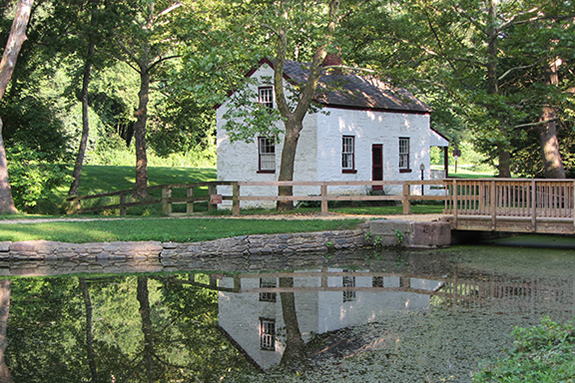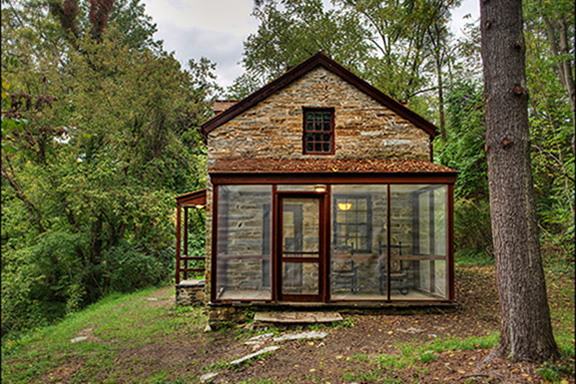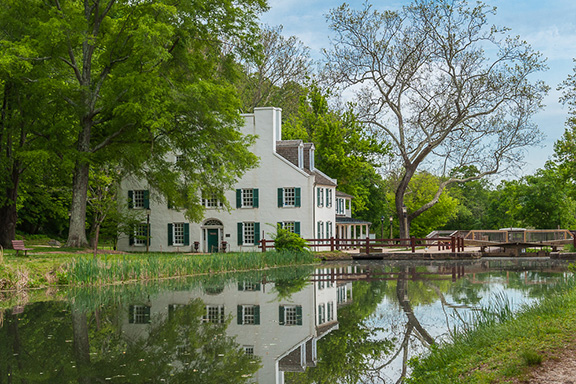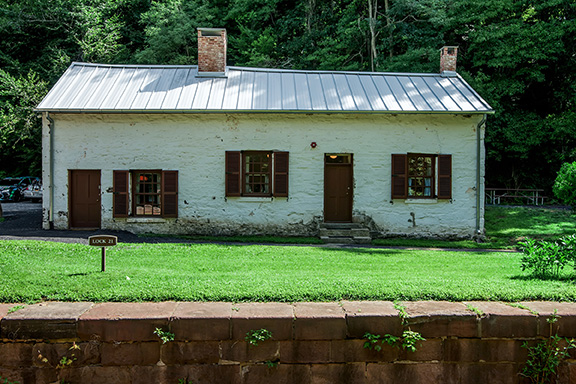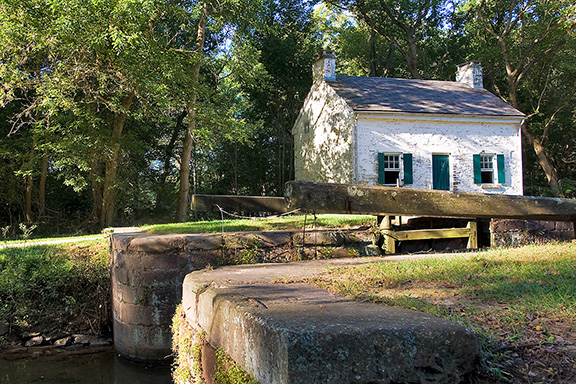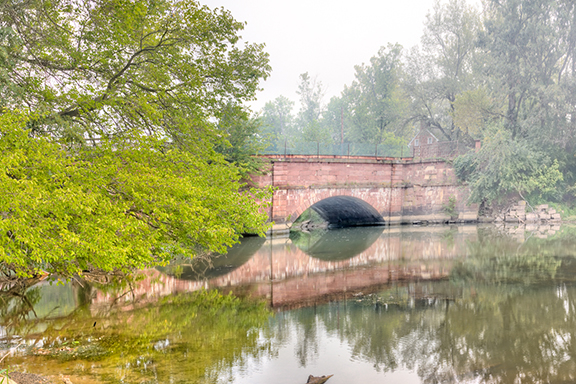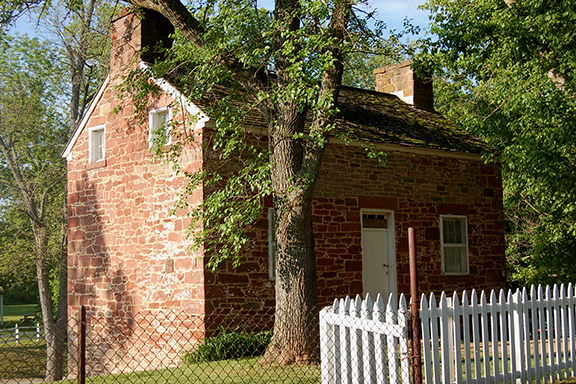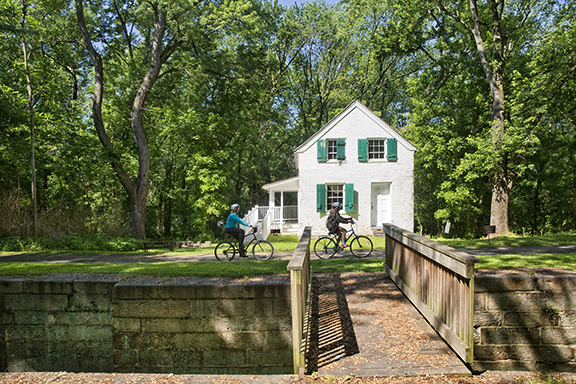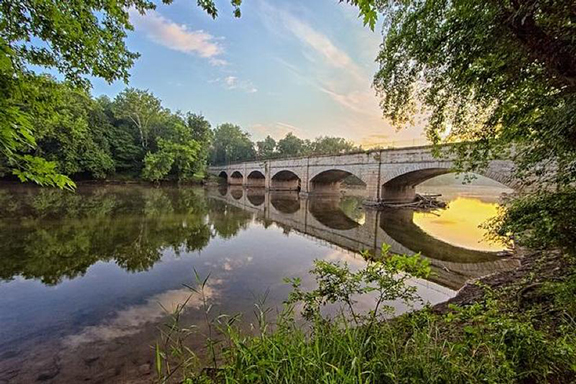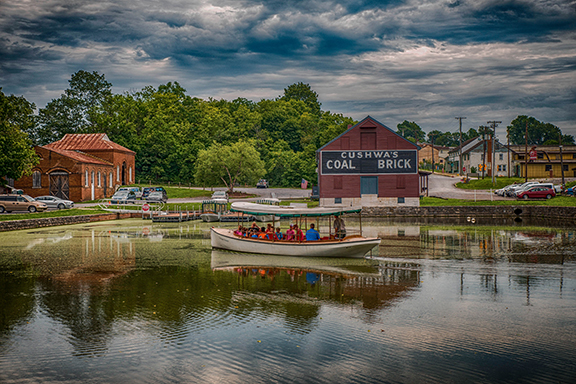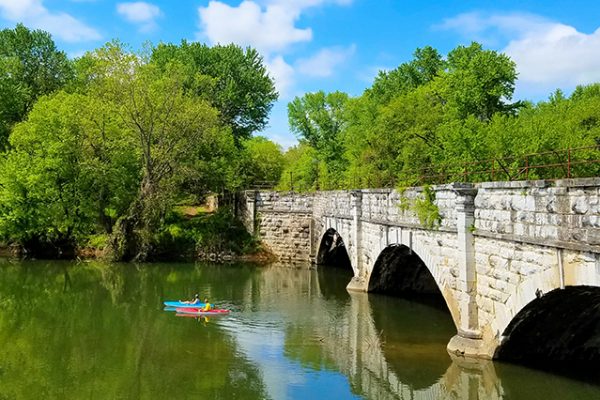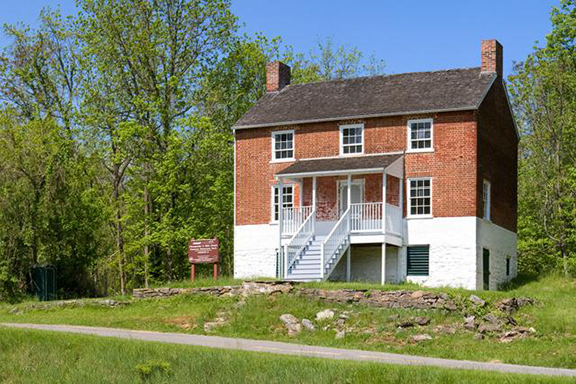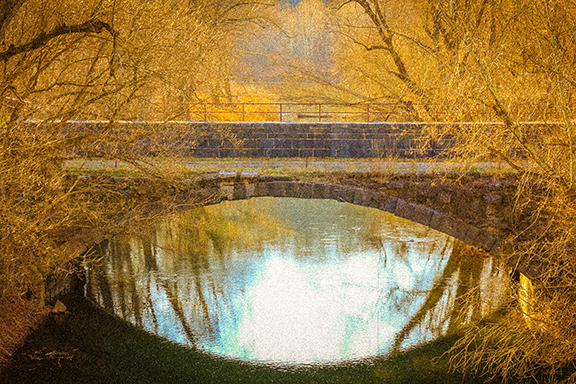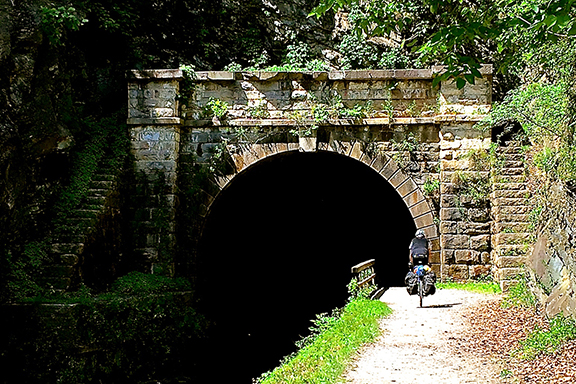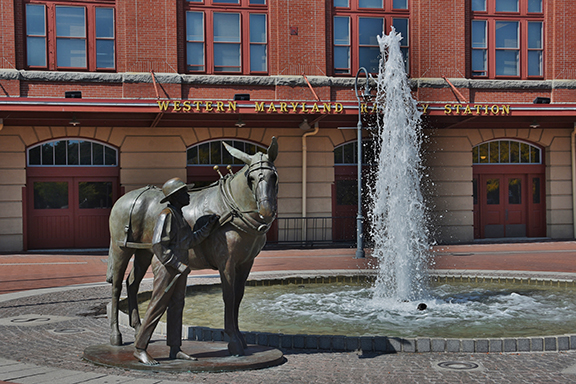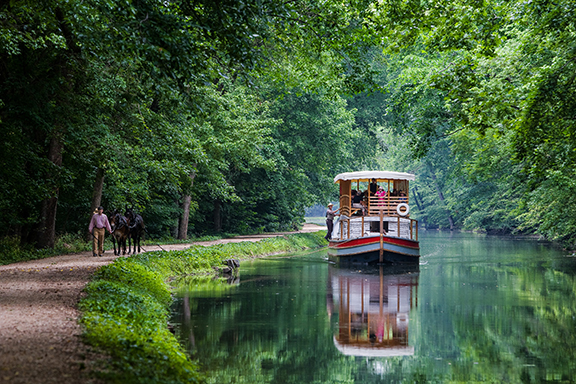
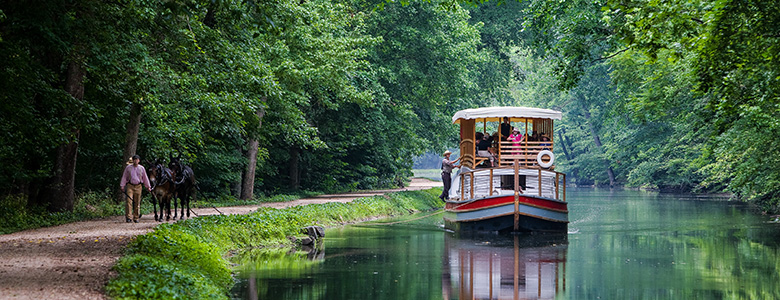
Mules pull visitors up the canal on the Charles F. Mercer canal boat. Photo by Roy Sewall
Although the canal stopped operating one hundred years ago, you can still step back in time and experience what life was like on the C&O Canal during its heyday. You’ll find a multitude of authentic canal experiences, historic structures you can visit or book a night’s stay in, and even canal boat rides, with and without mules.
You can also copy this itinerary into our C&O Canal Itinerary Builder here.
Canal Quarters Lockhouses
Arguably the most unique experience you can have is to stay in an historic lockhouse! The Canal Quarters program features seven authentic lockhouses along the C&O Canal that have been preserved and are available to guests for overnight stays. Step back in time and experience what life was like during the heyday of the canal. Each lockhouse has been furnished with furniture and accessories from a different time period and each tells a different story about the development of the C&O Canal. Each lockhouse can sleep up to eight people. Visit www.canalquarters.org for more information and to book your stay!
Aqueducts
Eleven aqueducts stand along the C&O Canal – some of the most impressive of the canal structures that stand today. Aqueducts transported the canal over streams and tributaries. Several have been rebuilt, including the Conococheague Aqueduct in Williamsport, which is watered and is one of the only places in the country where you can ride a boat over an aqueduct. Learn more about the C&O Canal’s aqueducts here.
Other Experiences
The C&O Canal National Historical Park offers a variety of other authentic canal experiences, including boat rides and historic canal structures you can visit. Read on for more, or view by region: East | Central | West
East: DC to Brunswick
Mile Marker 1.0 Alexandria Aqueduct
An earlier attempt to relieve the congestion of canal boats unloading cargo in Georgetown, the Potomac Aqueduct allowed canal boats to cross over the Potomac River, connect with the Alexandria Canal, and deliver goods to the wharves at Alexandria, Virginia. This structure was built between 1833 and 1843. Only two of the aqueduct’s abutments and one pier near the Virginia shore remain today.
Mile Marker 3.1 The Abner Cloud House
One of the oldest existing structures on the Canal, the Abner Cloud House and nearby mill date back to 1801. The site provided grain and excellent quality flour called “Evermay” to Washington, D.C. for nearly 70 years. Only ruins of the mill remain, but the house was restored in the 1970s. Today, the Colonial Dames of America, Chapter III, periodically offers interpretive programs in the house.
Mile Marker 5.4 Lockhouse 6
Experience life on the canal with an overnight stay at Lockhouse 6, part of the Canal Quarters program. Lockhouse 6 is furnished in the 1950s time period and tells the story of Supreme Court Justice William O. Douglas’s walk of the entire 184.5-mile long towpath to help save the canal. Learn how you can spend the night in this lockhouse here.
Mile Marker 8.8 Lockhouse 10
Lockhouse 10 is also a part of the Canal Quarters program. Like Lockhouse 6, it provides a unique lodging option for your canal visit. It is furnished in the 1930s time period and tells the story of the Civilian Conservation Corps (CCC) efforts to preserve the canal. With a screened-in porch overlooking the canal and full amenities, this lockhouse provides a restful spot to recharge from your canal explorations. Learn how you can spend the night in this lockhouse here.
Mile Marker 14.4 Historic Great Falls Tavern and Canal Boat Program
Today, Great Falls Tavern, once known as the Crommelin House, is a visitor center for the C&O Canal National Historical Park, offering visitor services, exhibits, interpretive programs, and more. This grand two-story historic structure, completed in 1829, served a number of purposes through the years as a locktender’s house, a tavern, a hotel, and even a private club.
One of the most authentic experiences available on the C&O Canal is a canal boat ride. Experience life in the 1870s, a history lesson and a unique boat ride that includes a ride through a 19th century lock, complete with canal mules and costumed guides. You’ll get all this and more during an hour-long ride aboard the replica Charles F. Mercer canal boat at the Historic Great Falls Tavern. (Check www.nps.gov/choh for the schedule of boat rides. Rides are closed for 2020 and will resume in 2021.)
Mile Marker 16.7 Lockhouse 21 “Swains Lockhouse”
Also a part of the Canal Quarters program, Lockhouse 21 is also known as “Swains Lockhouse” after the family who lived there for over a century. This lockhouse interprets 1916, the year the National Park Service was formed and the date when the C&O Canal was beginning to transition from a working canal to a recreational space. The lockhouse has been completely modernized with full amenities, including an ADA-accessible bathroom and a Murphy bed on the first floor, ramps into the house, and hallways wide enough to accommodate a wheelchair. Learn how you can spend the night in this lockhouse here.
Mile Marker 19.6 Lockhouse 22
Experience life on the canal with an overnight stay at Lockhouse 22, part of the Canal Quarters program. Lockhouse 22 is furnished in the 1830s time period, reflecting on the early phase of canal construction and the architectural marvels that were necessary to make it functional. Step back in time and experience life as the lock keepers truly lived. Learn how you can spend the night in this lockhouse here.
Mile Marker 22.7 Seneca Aqueduct
Seneca Aqueduct and Lock 24 are combined into a single structure here, the only place along the canal that this was necessary. This is one of 11 aqueducts that carried the canal over major tributaries of the Potomac.
Mile Marker 22.7 Lockhouse 24 “Riley’s Lockhouse”
Riley’s Lockhouse is very well restored, with one-and-a-half stories over a full basement. Local Girl Scouts dressed in period clothing periodically provide interpretation and guide visitors through the historic home.
Mile Marker 30.9 Lockhouse 25
Experience life on the Canal with an overnight stay at Lockhouse 25, part of the Canal Quarters program. Lockhouse 25 is nestled in the sleepy town of Edwards Ferry and is furnished in the 1860s time period, telling the story of the Civil War’s impact on the Canal. Learn how you can spend the night in this lockhouse here.
Mile Marker 35.5 White’s Ferry
White’s Ferry is a one-of-a-kind on the Potomac River. Until it closed in 2020, it was the last operating ferry on the river, transporting vehicles, cyclists and pedestrians from Maryland across to the Leesburg area of Virginia.
Mile Marker 42.2 Monocacy Aqueduct
The Monocacy Aqueduct is the largest of the canal’s 11 stone aqueducts. It is often considered one of the two finest features of the C&O Canal. It was built from 1829-1833.
Mile Marker 49.0 Lockhouse 28
Lockhouse 28 is the most remote of all the Canal Quarters lockhouses, located nearly a half mile from the nearest parking. This rustic retreat was completed in 1837 and is a reminder of the fierce competitive race between the Chesapeake & Ohio Canal and the Baltimore & Ohio Railroad in the race to reach the Ohio River Valley. Learn how you can spend the night in this lockhouse here.
Mile Marker 51.5 Catoctin Aqueduct
The Catoctin Aqueduct is listed on the National Register of Historic Places. It was built with two semi-circle arches on either side of an elliptical arch. The elliptical arch was not structurally strong and began to sag, leading to structural failure. In 1973 two arches collapsed leaving only a remnant of the eastern arch standing. The Park Service buried the original stones to help preserve them in case the aqueduct was ever restored, which began in 2007. The restored aqueduct was dedicated and re-opened in 2011.
Central: Brunswick to Hancock
Mile Marker 69.4 Antietam Aqueduct
The Antietam Aqueduct is the fourth of 11 stone aqueducts in the Park. The 140-foot structure is built of limestone from a nearby quarry and has three elliptical arches. It’s located near Antietam Battlefield but actually sustained extensive damage by the Confederates during General Jubal Early’s invasion of Maryland in 1864. Learn more about the C&O Canal’s aqueducts here.
Mile Marker 99.2-99.8 Williamsport Visitor Center/Cushwa Basin
The historic Cushwa Basin warehouse is open seasonally as the C&O Canal Visitor Center in Williamsport, interpreting the 1920s time period on the canal. The Park staff offer boat tours at Williamsport/Cushwa Basin on a replica launch boat that passes over the refurbished Conococheague Aqueduct. It’s the only place in North America where visitors can see a lift lock and refurbished lockhouse, a railroad lift bridge, a canal turning basin, and a re-watered aqueduct. Lockhouse 44 is fully furnished on the lower level and is open to visitors periodically throughout the spring and summer. Visitors can step back in time to learn about what lock keepers did and how they lived. Inside the Cushwa Basin warehouse visitors will find interpretive exhibits and visitor information. The Trolley Barn at Cushwa Basin features hands-on activities for children and replica historic toys. Days and times may vary for boat tours and visitation to Lockhouse 44 and the Trolley Barn. Visit the Park’s website for more information.
Mile Marker 99.6 Conococheague Aqueduct
Completed in 1834, the Conococheague Aqueduct was built of limestone from nearby quarries. The aqueduct has three equal arch spans. Both armies launched raids against the aqueduct during the Civil War. Years later, the berm wall collapsed early on the morning of April 20, 1920. The boat traveling across the aqueduct fell into the Conococheague Creek and remained there until the 1936 flood carried it down the Potomac. A full restoration of the aqueduct was completed in 2019. Canal launch boat rides across the re-watered aqueduct are offered seasonally. Learn more about the C&O Canal’s aqueducts here.
Mile Marker 108.9 Lockhouse 49
Experience life on the Canal with an overnight stay at Lockhouse 49, part of the Canal Quarters program. Lockhouse 49 is a two-story lockhouse furnished in the 1920s time period that tells the story of the canal community at Four Locks. With four canal locks located so closely together, the community was truly a canal community with stores, warehouses, a dry dock for boat repair, a school, a post office and a dozen houses. Learn how you can spend the night in this lockhouse here.
Mile Marker 116.1 Licking Creek Aqueduct
The 90-foot, single-span aqueduct was described by the C&O Canal Company in 1839 as “one of the longest, if not the longest, aqueduct arch which has been constructed in the United States.” Constructed between 1836 and 1838, the structure is largely built of limestone and cement transported from nearby Hook’s mill, just across the river from Hancock. The aqueduct was first used in 1839 when the canal was watered from Dam no. 6 down to Dam no. 5. This was the same year canal operations began in the town of Hancock. Learn more about the C&O Canal’s aqueducts here.
Mile Marker 122.8 Bowles House/Hancock Visitor Center
The historic Bowles House is open seasonally as the C&O Canal Visitor Center in Hancock. The house was built in the 1780s as a one-story structure overlooking the Potomac. The parcel of land, known as “Sarah’s Fancy,” was transferred from Lord Baltimore to William Yates around 1775. The Yates family occupied the house during canal construction until 1875, when it was acquired by the Bowles family. They remained in the house until 1905. Visitors can enjoy sitting on the front porch and, on occasion, may have the treat of hearing a ranger or local resident play banjo or acoustic guitar. Visit the Park’s website for more information and hours.
Mile Marker 123.0 Tonoloway Aqueduct
Constructed between 1835 and 1839 of limestone extracted upstream on Tonoloway Creek, Tonoloway Aqueduct carried canal boats across Tonoloway Creek, a 31-mile tributary of the Potomac River. Cement for the aqueduct came from Captain Hook’s mill but during a water shortage in the summer of 1837, cement was imported from Boteler’s Mill and Baltimore. Learn more about the C&O Canal’s aqueducts here.
West: Hancock to Cumberland
Mile Marker 136.6 Sideling Hill Creek Aqueduct
The Sideling Hill Creek Aqueduct was built between 1837 and 1840, primarily using Tonoloway Limestone from the quarry at the mouth of the Cacapon River, as well as Pocono sandstone rubble from Sideling Hill. The aqueduct has a single arch with a 70-foot span. The creek marks the boundary between Washington and Allegany Counties. Learn more about the C&O Canal’s aqueducts here.
Mile Marker 140.9 Fifteenmile Creek Aqueduct
The Fifteen Mile Creek Aqueduct is a small, single-arch aqueduct. Built between 1838 and 1850, it is in excellent condition for a century and a half old structure. It was constructed with hard flint stone quarried at Sideling Hill on the West Virginia side of the river. In 1842, during construction, the canal company ran out of funds and work was suspended for a time, but finally, work was completed and the aqueduct began service in 1850. Learn more about the C&O Canal’s aqueducts here.
Mile Marker 155.0 Paw Paw Tunnel
It took 12 years and nearly all of the Canal Company’s funds to complete the Paw Paw Tunnel, but it opened to traffic on October 10, 1850. The tunnel was built to save five miles of construction by cutting across a neck of land formed by the Paw Paw bends. What resulted was the most notable landmark on the Canal—at three-fifths of a mile and 5,800,000 bricks in all.
Mile Marker 162.4 Town Creek Aqueduct
Town Creek Aqueduct is a single-span aqueduct. Construction began in 1837 and was abandoned in 1838 when the contractor quit during the Canal company’s financial crisis. It was completed during the final phase of C&O Canal construction (1848-1850) by Michael Byrne. It is the tenth of eleven aqueducts on the Canal and, like many of the other eleven, is missing its upstream wall. Learn more about the C&O Canal’s aqueducts here.
Mile Marker 180.7 Evitts Creek Aqueduct
The Evitts Creek Aqueduct is the last of the 11 aqueducts on the Canal, and is made of “Fossilferous Tonoloway Limestone” quarried upstream and shipped to the aqueduct via a 1.5 mile railroad. Work began in 1839 and was completed in 1841 when the Canal Company ran out of funds, with final touches and service beginning in 1850. Learn more about the C&O Canal’s aqueducts here.
13 Canal St., Cumberland “The Cumberland” Canal Boat Replica
Visitors can tour “The Cumberland,” a full-sized replica canal boat constructed in 1976. Guides in period clothing interpret the history of the canal and daily life aboard a canal boat. Visitors can also tour the mule shed, hay house and furnished Captain’s cabin. Visit the Park’s website for more information and hours.

